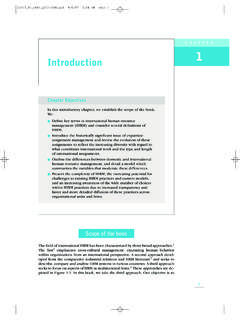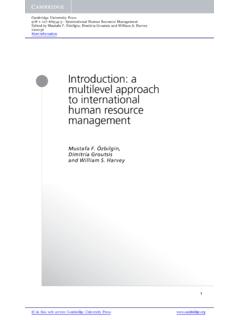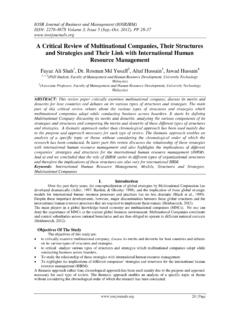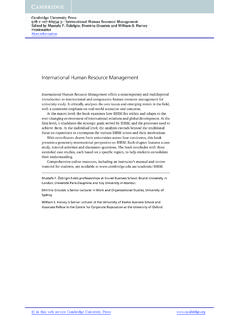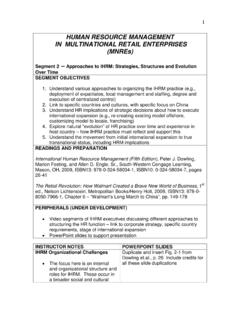Transcription of INTERNATIONAL HUMAN RESOURCE …
1 INTERNATIONAL HUMAN RESOURCE Subject: INTERNATIONAL HUMAN RESOURCE management Credits: 4 SYLLABUS Introduction and Overview The scope of IHRM, Variables that Moderate Differences between domestic and INTERNATIONAL HRM. INTERNATIONAL HUMAN RESOURCE management Approaches The Path to Global Status Mode of Operation INTERNATIONAL Staffing & Performance management Executive Nationality Issues- Staffing Policies Issues in Staff Selection, Multinational Performance management Factors associated with Individual Performance and Appraisal Criteria Used for Performance Appraisal of INTERNATIONAL Employees Training and Development& Compensation Expatriate Training Developing INTERNATIONAL Staff and Multinational Teams, Approaches to INTERNATIONAL Compensation Labor Relations Key issues in INTERNATIONAL Labor Relations Labor Unions and INTERNATIONAL Labor relations The response of Labor Unions to Multinationals Regional Integration The European Union (EU)
2 Regional Integration The North American Free Trade Agreement (NAFTA) Issues, Challenges, and Theoretical Developments in IHRM Managing people in an INTERNATIONAL Context India HUMAN Resources Issues in Multinational corporate Social responsibility concluding remarks, HR Practices in UK, USA and Japan Suggested Readings: 1. Pemberton, William E. HUMAN Rights: Humanistic Visions, Imperialistic Realities, University of Wisconsin-La Crosse. 2. Stajkovic, Alexander D. and Fred Luthans Business Ethics Across Cultures: A Social Cognitive Model in Best Practices in INTERNATIONAL Business edited by Michael R. Czinkota and Ilka A. Ronkainen, Harcourt College Publishers. 3. Pena, Leticia "Values in INTERNATIONAL Business: Faces of a Faceless Labor Force," Journal of HUMAN Values, 4: 1, Sage Publications.
3 COURSE OVERVIEW The Course is designed to build a knowledge base of the contemporary practices and issues in INTERNATIONAL HUMAN RESOURCE management . This course examines how country level differences in factors such as labour employment laws and trade union interact with national cultural expectations to create distinctive employment systems between the countries. An implication that managing HUMAN RESOURCE vary from country to country. It provides a thorough understanding of how to design and implement HR practices which meet the dual demand s of global integration and local flexibility. It will examine how re-sourcing, rewarding and development practices need to be adapted when working in a cross border environment.
4 The aim of the course is to provide an understanding of the theoretical concepts and the practical implications of INTERNATIONAL HRM and to take strategic view of some of the new developments in INTERNATIONAL HRM. In particular it looks at HR's role on creating organizational capability on global scale and gives an overview of HUMAN RESOURCE management in an INTERNATIONAL environment. The emergence of the multinational enterprise as a dominant institution in world economy has resulted in the importance of understanding not only multinational enterprises themselves, but also the activities of the people working within these and similar multi-cultural organizations. This course examines how country level differences in factors such as labour employment laws and trade union interact with national cultural expectations to create distinctive employment systems between the countries.
5 An implication that managing HUMAN RESOURCE vary from country to country. It provides a thorough understanding of how to design and implement HR practices which meet the dual demand s of global integration and local flexibility. It will examine how re-sourcing, rewarding and development practices need to be adapted when working in a cross border environment. It will contextualize a diversity of HUMAN RESOURCE practices in corporate strategy and organization development in conditions of globalization. On successful completion of the course students will be able to understand distinctive features of INTERNATIONAL HRM. Appreciate links between corporate strategy, organizational structure, corporate culture and their impact on HRM in an INTERNATIONAL setting, the significance of cross-cultural differences in management theory and practice, explain the differences and similarities among countries in the practice of major HUMAN RESOURCE management functions, and describe the major employment policies of multinational companies and the potential problems of cross-cultural differences.
6 The detailed syllabus, analyzes the relevance of this knowledge base in today s global work culture, wherein students learn to appreciate behavioral nuances and value systems of the work force in a multi-cultural setting. The course requires the students to inculcate the corporate etiquettes needed to manage people in an INTERNATIONAL environment. i 1 Learning Objectives 1. Why is the study of INTERNATIONAL HUMAN RESOURCE management important for businesses? 2. How the course or practice of HUMAN RESOURCE management is studied, understood or approached? It is discussed under the head Approaches to INTERNATIONAL HUMAN RESOURCE management 3. What is INTERNATIONAL HUMAN RESOURCE management ? Definition of INTERNATIONAL HUMAN RESOURCE management will give you a broad outline about what is in this subject?
7 You will also learn about PCNs, HCNs. and TCNs. Introduction Importance of INTERNATIONAL HUMAN RESOURCE management INTERNATIONAL business is dynamic. Business is crossing borders. Globalization is gaining momentum. Markets are no longer protected from foreign competition. Markets are now open for competition from both domestic and foreign firms. A large proportion of workforce are located in other countries away from their homes and home countries. For example, Ford Motor Company has half its employees outside the United States, Philips has three-fourths of its employees working outside the Netherlands and more than half of Ericsson s workforce is located outside Sweden. Issues of managing business are becoming more and more complex in the same pace as globalization is taking placing.
8 The unusual level of foreign competition in both domestic and foreign markets is forcing businesses to find and retain the competitive advantage. Finding and nurturing the suitable and capable HUMAN resources in the context of high competition at both domestic and INTERNATIONAL levels is high on the list of priorities of the top managements. Quality HUMAN resources are a must for implementing global competitive strategies. Firms expanding into INTERNATIONAL markets are put under additional pressure to manage their limited resources and for such firms managing HUMAN resources is more essential than any other firm. Any problem is either created by people or must be solved by people. Having right people in the right place at the right time is key to a company s INTERNATIONAL growth.
9 Approaches to INTERNATIONAL HUMAN RESOURCE management Cross-cultural management : One approach stresses on cross-cultural management . It examines HUMAN behavior within organizations from an INTERNATIONAL perspective. Culture which varies from country to country at least on a few dimensions like family, work ethics, business practices etc. It makes all the difference. 2 Comparative Industrial Relations: The second approach, which was developed from comparative industrial relations describes, compares and analyses HRM systems in various countries. It is a study of countries, their work patterns and managerial practices. management of Multinational Firms: The third approach focuses on aspects of HRM in multinational firms.
10 In this the focus is on the management of multinational firms having operations in different countries and finding universal principles that apply to the operations of the multinationals across the world. What is INTERNATIONAL HRM? Let us first examine what activities constitute HRM. All those activities undertaken by an organization to utilize its HUMAN resources effectively makes HRM. Those activities include: HUMAN RESOURCE Planning Staffing Performance management Training and development Compensation and benefits Labor relations The above activities will have a change whenever a firm or its HRM goes INTERNATIONAL . Three Dimensions of INTERNATIONAL HRM activities: 1. Procurement, allocation, and utilization of HUMAN resources. These are listed under HRM.

